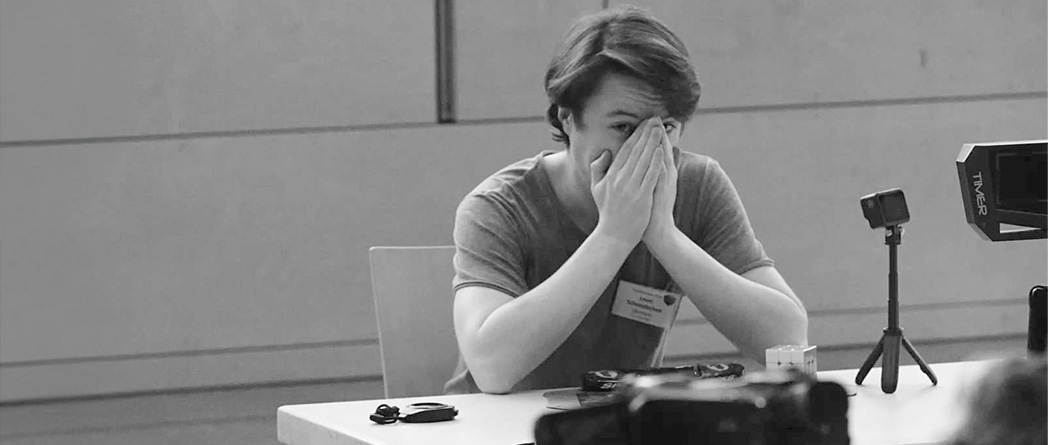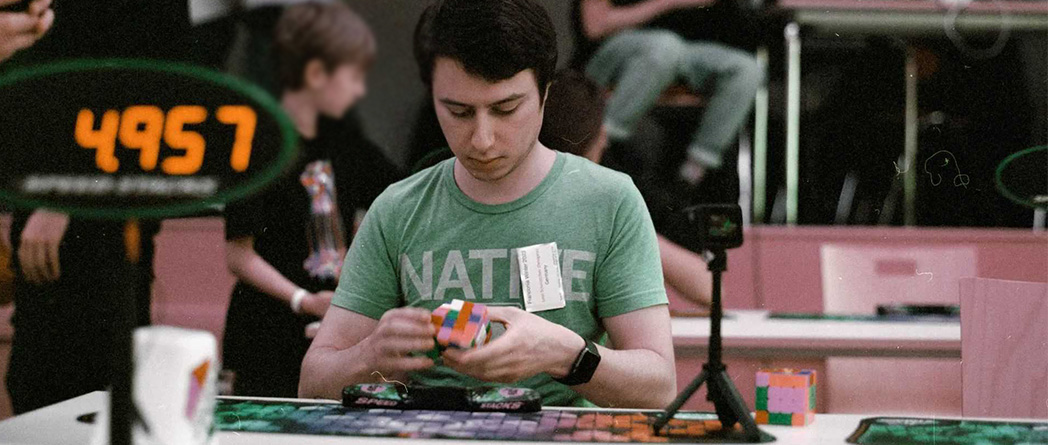We’ve all seen the shortcut used in film to demonstrate “this character is a genius”: simply show them solving a Rubik’s Cube. In reality, solving the cube—Rubik’s brand or otherwise—is something that is very structured, organized, and in some ways, repetitive.
The classic 3x3 cube is always solved the same way. First the bottom layer, then the middle layer, then the top layer, using a series of algorithms to change the color patterns bit by bit until it’s solved. There are thousands of algorithms; some are more efficient than others, but deploy them correctly, and you’ll end up with all sides solved.
When speedcubing becomes passion
What is an algorithm (or alg)? It’s a series of turns that you execute once you’ve identified a certain color pattern. For example: R U R' U' are the directions to turn for the four-turn trigger called “The Hamburger Move” or “The Move”, which is a must-know when learning algs.
Talking about the fastest execution of algorithms, at the time of writing, the record holder for the 3x3 single solve is held by Max Park at 3.13 seconds. But Park didn’t simply stumble upon the record. This solve was an “official solve”, meaning it was achieved while competing at a World Cubing Association (WCA) competition.
There is one skill upon which every great speedcuber heavily relies: spatial reasoning. Spatial reasoning is a critical component to IQ, and it’s the ability to visualize how shapes and figures move and change in space.
To delve more into the connection between spatial reasoning and IQ, TerraYou spoke with speedcuber and WCA delegate, Leon Schmidtchen.
Inspection, Look Ahead, and twisty puzzles
TerraYou: How long exactly have you been cubing, Leon?
Schmidtchen: I first solved a cube in 2008. I was 11 years old, still very young and not used to the internet, so I was only using the beginner's method, and solving at 40 seconds for about a year. I’ve been speedcubing since my first competition in 2010.
TY: As a speedcuber, you can obviously solve the 3x3, but how many other puzzles can you solve?
Schmidtchen: This is a difficult question because with the 3x3, in theory, you could just make it bigger and bigger. I can solve a 6x6, 7x7, 8x8 theoretically up to infinity. Let’s just say, I can solve all the standard, WCA shapes. Wait, I can’t solve Square-1. It’s easier to list what I can’t solve!

TY: What’s your favorite puzzle?
Schmidtchen: 3x3, for sure. Favorite way to solve it? With both hands.
TY: Of course, the one-handed solve is an official event! For a typical, two-handed solve, could you walk us through what’s involved?
Schmidtchen: The first question I always get is: "Is there a trick?" There is kind of a trick: it's the method. A good starting point is actually beginning at the end of the solve. At the last step, we recognize the pattern of the cube’s current state and know there's 21 ways to finish. We identify the most appropriate algorithm, and then the fingers apply it.
That's how all of it works. Beginner's method, advanced method, this basic concept is always the same: you have patterns in your head that you know how to solve, you recognize them, you apply the alg. There is more nuance at the beginning of the solve because no pieces are solved, so you have much more freedom. This is where something called “Look Ahead” comes in. It’s trying to visualize the next pattern while you are still on your current one.
TY: Look Ahead is one of the ways spatial reasoning is used in cubing because your mind is visualizing a version of the cube that you aren’t yet holding in your hands. Many cubers say “Look Ahead beats fast fingers every time”. Would you agree?
Schmidtchen: As long as you're not in the fastest 1000 worldwide, then I’d definitely agree that Look Ahead is more important than finger tricks. You see a lot of newcomers disregarding this advice. They solve one algorithm in half a second because they turn so fast, but then they have a two second pause because they didn't Look Ahead. They didn't know what their next case was going to be, and that really slows them down. If they were turning half as quick but Looking Ahead, the pause would shrink, and they’d be quicker overall.

TY: During competitions, cubers are given 15 seconds to inspect the cube before the solve begins and the clock starts ticking. Inspection plays a big role in a cuber’s final time. Why is that?
Schmidtchen: Inspection is where spatial reasoning is most at play. You aren't turning the cube; you're getting it in one certain state. The goal of inspection is to have the best spatial reasoning. You're trying to look as far ahead into your solve as you can without turning—you're just applying the moves in your head.
For example, if you want to practice spatial reasoning, what a lot of those super quick cubers do is practice at home not by taking 15 seconds like in a competition, but by taking as long as they need: one minute, five minutes. They just keep trying to “spatial reason” their way deeper and deeper into the solve. Then that’s where finger tricks come into play. Assuming we’re at a competition and I had done the same, I would then apply those moves slower than they, so turning quickly is still necessary.
TY: Is the role of inspection similar for other puzzles?
Schmidtchen: For smaller cubes like 2x2 or Pyraminx, fast cubers plan the whole solve during inspection. There is no Look Ahead in those small puzzles—these days it all happens during inspection. In those 15 seconds, the world-class solvers mentally go through four, five, six different full solutions, then just pick the one that is the fastest to execute—the one that is the most finger-trick friendly. That's the peak of spatial reasoning in cubing.
Developing your spatial reasoning skills pays off since you can apply them often in your day-to-day life, and solving a Rubik’s cube—whether fast or slow—is certainly not the only way to do so. In fact, using mapping is another technique, and it’s one that a TerraYou article can walk you through.
If you’re looking for more resources to develop further, check our article library every so often as we publish more such techniques in the future. In the meantime, find out how strong your own spatial reasoning abilities are by taking TerraYou’s IQ test.
If you’re interested in the world of speedcubing, the WCA’s website will tell you more about competition rules and when the next competition will take place in your area.



